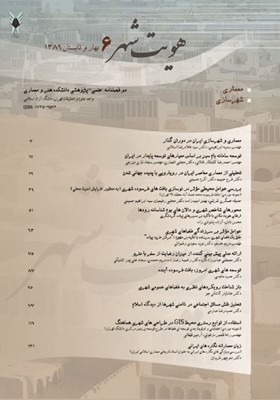محورهای شاخص شهری و دالان های بوم شناسانه رودها
محورهای موضوعی : معماریمحسن تابان 1 , آزاده پشوتنی زاده 2
1 - دانشجوی دکتری معماری، دانشکده هنر، دانشگاه تربیت مدرس، تهران، ایران. (مسئول مکاتبات)
2 - کارشناسی ارشد پژوهش هنر، دانشکده هنر، دانشگاه تربیت مدرس، تهران، ایران
کلید واژه: Place Identity, Index Urban Axis, Ecological River Corridors, Trail,
چکیده مقاله :
هویت را می توان به معنایی که انسان ها از طریق احساسات ذهنی از وجود هر روزه خود و ارتباطات گسترده اجتماعی کسب می کنند، تعریف کرد. لازمه درک هویت هر مکانی حضور، حرکت، مکث و تأمل در ویژگی های کالبدی، اجتماعی و کارکردی آن است که زمینه شناخت جامعی از آن مکان را فراهم می آورد. مسیرهای پیاده گردشگری دارای قابلیت بسیار در این زمینه اند. در این مقاله که از سنخ مقالات توصیفی با تکیه بر مطالعات اسنادی است، با بررسی محورهای شاخص شهری در ارتباط با دالان رودها، با توجه به مسیرهای پیاده؛ اصول حاکم بر شکل گیری آنها مورد شناسایی قرار گرفته است. این مسیرهای پیاده گردشگری در امتداد محورهای شاخص شهری، در اتصال به دالانهای بوم شناسانه رودها، با ایجاد اتصال بصری و فیزیکی و لحاظ کردن ملاحظات زیست شناسانه سبب ارتقای کیفیت و خوانایی فضای شهری گشته و متضمن پایداری مکان های شهری و هویت بخشی به محدوده های پیرامون و بالتبع کلیت شهر هستند.
Nowadays; definition of urban places and spaces is highly considered. Identity can be defined as the sense that people make of themselves through their subjective feelings based on their everyday experiences and wider social relations.Such experiences and relations need particular places. Places are significant centers of our immediate experiences of the world. In the past, human life was sincerely attached to things and places. Overall, there are two ways in which place has been related to identity. The first is place identifications. This refers to a person’s expressed identification with a place, The second way in which place has been related to identity is through the term place identity, which calls for a more radical re-evaluation of the construct of identity. The forces of new technologies, globalization and ‘time-space-compression’ have worked to undermine roll of place in individual and social identity of communities , However, places play a potentially important part in the symbolic and physical dimension of human identification. Place identity is realized through presence, movement, standing and reflects on physical, social and functional features in which a comprehensive understanding of the place will be allowed. Cities are rediscovering their rivers. For at least the past 30 years, cities and towns have been turning back to their rivers, transforming industrial and derelict land into new parks, residences, and commercial space. The trend appears to be continuing and perhaps even accelerating, with major planning and construction efforts underway in waterfront cities around the world. After abusing urban rivers through years of hard use and neglect, we have come to realize they are valuable economic and community assets. This assets give the waterfront cities great opportunities that if been considered in new developments, would arise benefits for the whole city. Reconsidering waterfront areas as a valuable urban asset is one of the most interesting phenomena of urban renewal. In particular, river cities display an intimate and complex relationship with the water which should never be considered a limit but an extension of the urban fabric. Tourism pedestrian trails within the urban context, connected to ecological river corridors, provides a concept through sequence vision with all of it aspects for urban space experience. In this research a descriptive and analytical methodology is used to determine main principles of pedestrian trails along the index urban axes connected with the riverfront corridors, focusing on parameters that increase presence of people and as a result identity of riverfront places. The paper shows that tourism pedestrian trails along index urban axes connected to the ecological river corridor, causes sustainability of urban places and as a result identifies the adjacent area and the entire city. This visual and physical connectivity, considering environmental issues and an integrated redevelopment, would led to creating more livable ,identified and active urban public spaces. Such connections increase quality and legibility of urban spaces and elaborate the image of the city. Careful criticism of the city’s production of new urban spaces should be pursued to avoid foreclosing opportunities for articulating alternate urban futures.
_||_

